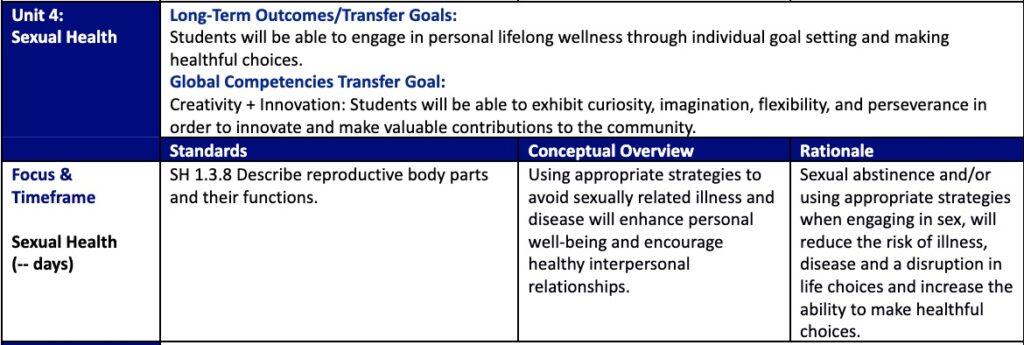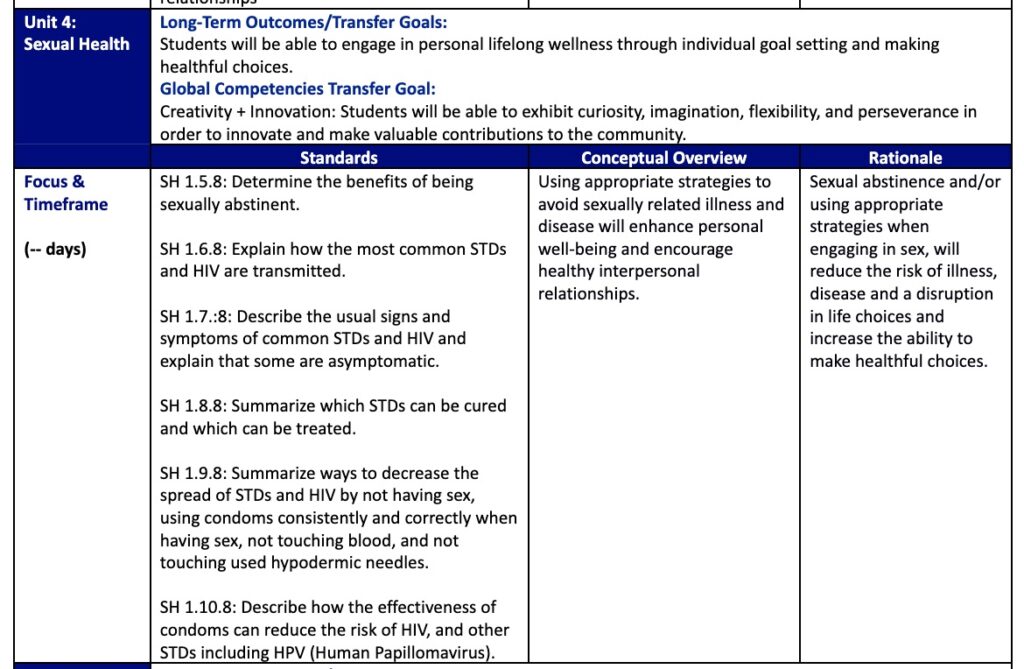
Report by Paula Antolini, March 28, 2022, 6:51PM EDT
(Warning explicit text.)
Do you know exactly what is being taught in Bethel Public Schools regarding “Sexual Health Education” in 6th to 9th grades? (age 11-15)
It appears that the Bethel Public Schools teach sex education, what the body parts look like and how they work, “the menstrual cycle, the process of sperm production and the relationship to conception,” how to use contraception, “appropriate strategies to avoid sexually related illness,” using “appropriate strategies” when “engaging in sex,” … “using condoms consistently and correctly when having sex,” so they can have “healthy interpersonal relationships.”
In fact, BPS teaches how to get rid of a baby in a variety of ways, with the “Safe haven laws,” and “accessing reproductive health resources as it relates to state laws and the “rights of minors.”
The CT State Dept. of Education suggests “sexual healthcare services for minors, including “emergency contraception, adoption, and abortion.” This is from a main resource BPS uses as a guide and chooses to follow.
The CT State Dept. of Education also suggests explaining “sexual activity and their associated risks (i.e., vaginal, anal, oral).”
BPS is even teaching “gender identity” such as “differences between cisgender, transgender, gender nonbinary, gender expansive, and gender identity” even though the latest CT legislation in HB6619 has not passed yet for gender studies yet (view lines 15-16). HB6619 wants to add: lesbian, gay, bisexual, transgender, queer, and other sexual orientations.“
Did parents ever agree to this curriculum? Were parents aver allowed to be part of the sexual health education decision process or give input on things like age-appropriate topics for which grades, or when sexual health education should begin? Or if it should be taught by the schools at all, without parents present? This is a topic parents usually like to speak to their children about themselves, and that they can best judge when their child is ready to learn about these sensitive topics. Perhaps it should be just an “opt in” course and not “opt out.”
*****
However, in these “sexual health” classes, BPS is likely not teaching anything about morals, being a responsible parent, or what family and dedicated love means. What it means to raise a child, or even the beauty and importance of long marriage and how different religions promote dedication, etc. is not taught. At least we do not see it listed. Some may think “religion” should not enter into school curriculum, but BPS has allowed “politics” to infiltrate schools, and that used to be objected to, and still is by many.
They do mention “abstinence” but only as a method to avoid pregnancy or sexual diseases, not teaching the meaning of waiting until marriage to have sex, or the sacred meaning of finding true love, marrying and cherishing a lifelong spouse, and loving children, etc.
BPS only encourages “healthy interpersonal relationships” and the CT State Dept. of Education suggests “limiting sexual partners” and “using protection.”
They teach the “process of fertilization and conception” but not the beauty and miracle of birth.
*****
Today we spoke to Dr. Christine Carver, Superintendent of Bethel Public Schools, asking her to discuss the text descriptions in the “Sexual Health, Unit 4” section of the school curriculum for grades 6-9. However, when we got down to the particulars she suggested we speak to Dr. Kristen Brooks, Assistant Superintendent of Bethel Public Schools, who was more knowledgeable on that topic.
Dr. Christine Carver did state that the BPS courses followed the CT guidelines from the following:
They recommend 12 hours per grade sequence of Sexual Health Education.
*****
Here is the CT State Dept. of Education suggested Sexual Health curriculum:
Under “Health Education Section | Core Concepts” – “Sexual Health (SH)” For Grades “PK-12″ it reads in part:
*****
Grades PK-2 (age 4-8):
“SH 1.2.2 Identify those parts of the body that are considered private by using medically accurate names.”
*****
Grades 3-5 (age 8-11):
SH 1.1.5 Describe basic reproductive body parts and their functions.
SH 1.2.5 Explain common human sexual development and the role of hormones (e.g., romantic and sexual feelings, masturbation, mood swings, timing of pubertal onset).
SH 1.3.5 Describe the range of physical, social, and emotional changes that occur during puberty.
SH 1.4.5 Explain how puberty and development can vary greatly and still be normal.
SH 1.5.5 Describe how people are similar and different (e.g., sexual identity, gender, gender identity, gender expression, etc.)
*****
Grades 6-8 (age 11-14):
SH 1.1.8 Identify resources, products, services related to supporting sexual health.
SH 1.2.8 Explain sexual activity and their associated risks (i.e., vaginal, anal, oral).
SH 1.3.8 Describe reproductive body parts and their functions.
SH 1.4.8 Describe the menstrual cycle, the process of sperm production and the relationship to conception.
SH 1.5.8 Determine the benefits of being sexually abstinent.
SH 1.6.8 Explain how the most common STDs and HIV are transmitted.
SH 1.7.8 Describe the usual signs and symptoms of common STDs and HIV and explain that some are
asymptomatic.
SH 1.8.8 Summarize which STDs can be cured and which can be treated.
SH 1.9.8 Summarize ways to decrease the spread of STDs and HIV by not having sex, using condoms
consistently and correctly when having sex, not touching blood, and not touching used hypodermic needles.
SH 1.10.8 Describe how the effectiveness of condoms can reduce the risk of HIV, and other STDs including HPV (human papillomavirus).
SH 1.11.8 Explain the significance of the physical changes in puberty and the potential role of hormone
blockers on young people who identify as transgender.
SH 1.12.8 Define and explain differences between cisgender, transgender, gender nonbinary, gender
expansive, and gender identity
*****
Grades 9-12 (age 14-18)
SH 1.1.12 Summarize the use of contraceptives and their relationship to the process of fertilization and conception.
SH 1.2.12 Explain the importance of and ability to access contraceptive, STD and HIV counseling and services if sexually active.
SH 1.3.12 Discuss state and federal laws and guidelines (e.g., CDC) that address sexual healthcare services for minors (e.g., contraception, emergency contraception, prenatal care, adoption, abortion, STD, including HIV, prevention, testing, and treatment.
SH 1.4.12 Examine the factors that protect one against engaging in sexual risk behaviors (e.g., values clarification, planning ahead, being prepared, communicating and respecting boundaries).
SH 1.5.12 Summarize ways to reduce the risk of pregnancy, HIV, and other STD’s (e.g., abstinence, avoiding alcohol and other drugs, limiting sexual partners, using protection).
SH 1.6.12 Compare and contrast the advantages and disadvantages of contraceptive and disease prevention methods (e.g., abstinence, condoms, emergency contraception).
SH 1.7.12 Justify why abstinence from sex and drugs are the safest, most effective risk avoidance methods of protection from HIV, other STDs, and pregnancy.
SH 1.8.12 Examine the effectiveness of typical use of condoms and other barrier methods in reducing the risk of pregnancy, HIV, and other infection by STDs, including HPV (human papillomavirus).
SH 1.9.12 Evaluate the benefits of biomedical approaches to prevent STDs (e.g., hepatitis B vaccine, HPV vaccine) and HIV (e.g., PrEP, PEP).
SH 1.10.12 Explain the importance of lowering the viral load of a person living with HIV to undetectable and maintaining viral suppression.
SH 1.11.12 Examine the effectiveness of typical use of a variety of contraceptives in preventing pregnancy, HIV and STDs.
SH 1.12.12 Summarize the short- and long-term consequences, including symptoms and treatment costs, of common STDs and HIV and the problems associated with asymptomatic STDs and HIV.
SH 1.13.12 Explain why it is important to know the STD/HIV status of oneself and of a potential sexual partner.
SH 1.14.12 Explain the state and federal laws related to Safe Haven Law, parenting, and sterilization, including their impacts on oppressed communities.
SH 1.15.12 Describe the emotional, social, physical, and financial effects of being a teen parent.
SH 1.16.12 Differentiate between sexual orientation, sexual behavior, and sexual identity
*****
Here is the present Bethel Public Schools Sexual Health Education Curriculum:
The Bethel Public Schools (BPS) Curriculum Charts are available on the BPS website for the Secondary Grade Levels 6-8 (age 11-14) and BHS Grade 9 (age 14-15) in a section called “Unit 4, Sexual Health.” VIEW BELOW.
BETHEL MIDDLE SCHOOL (Grades 6-8)
*****
For 6th Grade (age 11-12):
Standards –
SH 1.3.8 Describe reproductive body parts and their functions.
Conceptual Overview –
Using appropriate strategies to avoid sexually related illness and disease will enhance personal well-being and encourage healthy interpersonal relationships.
Rationale –
Sexual abstinence and/or using appropriate strategies when engaging in sex, will reduce the risk of illness, disease and a disruption in life choices and increase the ability to make healthful choices.

*****
For 7th Grade (age 12-13):
Standards –
SH 1.2.8 Explain sexual activity and their associated risks
SH 1.4.8 Describe the menstrual cycle, the process of sperm production and the relationship to conception.
Conceptual Overview –
“Using appropriate strategies to avoid sexually related illness and disease will enhance personal well-being and encourage healthy interpersonal relationships.”
Rationale:
Sexual abstinence and/or using appropriate strategies when engaging in sex, will reduce the risk of illness, disease and a disruption in life choices and increase the ability to make healthful choices.

*****
For 8th Grade (age 13-14):
Standards –
SH 1.5.8: Determine the benefits of being sexually abstinent.
SH 1.6.8: Explain how the most common STDs and HIV are transmitted.
SH 1.7.:8: Describe the usual signs and symptoms of common STDs and HIV and explain that some are asymptomatic.
SH 1.8.8: Summarize which STDs can be cured and which can be treated.
SH 1.9.8: Summarize ways to decrease the spread of STDs and HIV by not having sex, using condoms consistently and correctly when having sex, not touching blood, and not touching used hypodermic needles.
SH 1.10.8: Describe how the effectiveness of condoms can reduce the risk of HIV, and other STDs including HPV (Human Papillomavirus).
Conceptual Overview –
Using appropriate strategies to avoid sexually related illness and disease will enhance personal well-being and encourage healthy interpersonal relationships.
Rationale:
Sexual abstinence and/or using appropriate strategies when engaging in sex, will reduce the risk of illness, disease and a disruption in life choices and increase the ability to make healthful choices.

*****
BETHEL HIGH SCHOOL (Grades 9-12 but only Grade 9 is listed for Sexual Health Education IN BPS)
*****
For 9th Grade (age 14-15):
Standards –
SH 1.1.12 Summarize the use of contraceptives and their relationship to the process of fertilization and conception.
SH 1.2.12 Explain the importance of and ability to access contraceptive, STD and HIV counseling and services if sexually active.
SH 1.3.12 Accessing reproductive health resources as it relates to state laws and the rights of minors.
SH 1.4.12 Explain the effects of alcohol and other drug use during pregnancy.
SH 1.5.12 Analyze the factors that protect one against engaging in sexual risk behaviors (e.g. values clarification, planning ahead, being prepared, communicating and respecting boundaries).
SH 1.6.12 Summarize ways to reduce the risk of pregnancy, HIV and other STD’s (e.g. abstinence, avoiding alcohol and other drugs, limiting sexual partners, using protection).
SH 1.7.12 Justify why abstinence from sex and drugs are the safest, most effective risk avoidance methods of protection from HIV, other STDs, and pregnancy.
SH 1.8.12 Analyze the effectiveness of typical use of condoms and other barrier methods in reducing the risk of pregnancy, HIV, and other infection by STDs, including HPV (Human Papillomavirus).
SH 1.9.12 Analyze the effectiveness of typical use of a variety of contraceptives in preventing pregnancy, HIV and STD’s.
SH 1.10.12 Summarize the short- and long-term consequences, including symptoms and treatment costs, of common STDs and HIV and the problems associated with asymptomatic STDs and HIV.
SH 1.11.12 Explain why it is important to know the STD/HIV status of oneself and of a potential sexual partner.
SH 1.12.12 Discuss the implication of the Safe Haven Law.
(Editor: “Safe haven laws generally allow the parent, or an agent of the parent, to remain anonymous and be shielded from criminal liability and prosecution for child endangerment, abandonment, or neglect in exchange for surrendering the baby to a safe haven.”)
*****
Conceptual Overview –
“Using appropriate strategies to avoid sexually related illness and disease will enhance personal well-being and encourage healthy interpersonal relationships.”
Rationale:
Sexual abstinence and/or using appropriate strategies when engaging in sex, will reduce the risk of illness, disease and a disruption in life choices and increase the ability to make healthful choices.

###
